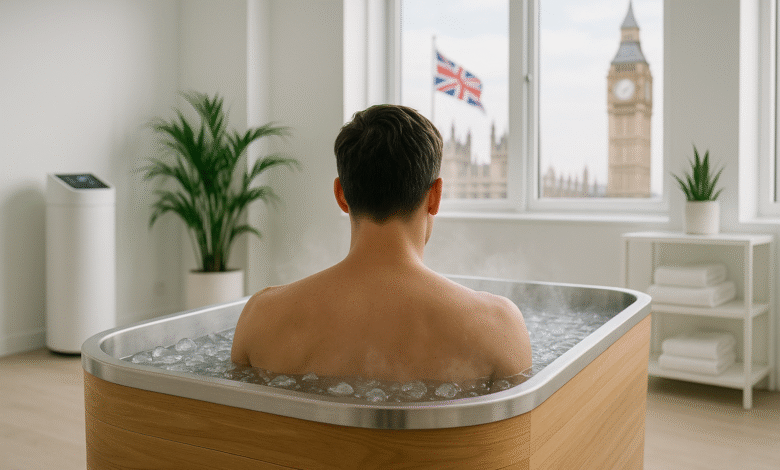How Cold Therapy and Ice Baths Are Becoming Mainstream in the UK
Cold therapy and ice baths are exploding in popularity across the UK, with 925% growth in interest. Discover benefits, trends, and where to experience this wellness revolution.

The sight of people voluntarily submerging themselves in freezing water would have seemed bizarre just a few years ago. Today, cold therapy and ice baths are taking the UK by storm, transforming from niche athletic recovery tools into mainstream wellness practices. From celebrities and influencers sharing their icy plunges on social media to luxury wellness centres offering state-of-the-art cold water therapy facilities, Britain has embraced the chill like no other nation.
The numbers tell a remarkable story. Interest in ice baths UK has skyrocketed by an unprecedented 925% compared to 500% in the United States, making Britain the global leader in cold water immersion enthusiasm. This dramatic shift represents more than just a fitness fad – it signals a fundamental change in how we approach wellness, recovery, and mental resilience. Young adults aged 18-24 are driving much of this growth, turning cold exposure from an extreme athletic practice into a lifestyle choice that promises enhanced energy, improved mood, and accelerated recovery.
EXPLORE THE CONTENTS
The Science Behind Cold Therapy’s Rising Popularity
Understanding Cold Water Therapy Mechanisms
Cold water therapy works by triggering a complex physiological response when the body encounters temperatures below 15°C. This cold shock response causes blood vessels to constrict, reducing inflammation and flushing metabolic waste from muscles. The practice activates the sympathetic nervous system, releasing norepinephrine and endorphins that create the euphoric feeling many users describe.
Research suggests cold water immersion can activate brown adipose tissue (brown fat), which burns calories to generate heat. This metabolic boost may contribute to weight management and improved cardiovascular health. The Global Wellness Institute reports that the cold therapy market, valued at £8.01 billion in 2022, is expected to reach £12.34 billion by 2030, reflecting growing scientific interest and commercial investment.
The Wim Hof Method Revolution
Much of the UK’s cold therapy boom can be attributed to Dutch athlete Wim Hof, whose method combines controlled breathing, cold exposure, and mental commitment. The Wim Hof Method has generated over 800,000 hashtag uses on Instagram and more than 100,000 monthly searches across the UK and US combined.
Hof’s approach promises practitioners the ability to:
- Boost immune system function through controlled stress exposure
- Enhance mental resilience and stress tolerance
- Improve circulation and cardiovascular health
- Reduce inflammation and accelerate recovery
- Increase energy levels and mental clarity
Scientific studies at Radboud University demonstrated that practitioners of the Wim Hof Method showed increased immune responses and fewer disease symptoms when exposed to pathogens, lending credibility to the practice’s health claims.
Ice Baths in UK Wellness Culture
From Athletic Recovery to Lifestyle Choice
Professional athletes like Andy Murray and Jessica Ennis-Hill have long used ice baths for recovery, but the practice has now transcended sports. UK wellness centres are reporting unprecedented demand for cold water therapy sessions, with facilities from London to Manchester integrating ice baths into luxury spa experiences.
Ice bath benefits that attract mainstream users include:
- Reduced muscle soreness and faster recovery after exercise
- Improved sleep quality and deeper rest
- Enhanced mood through natural endorphin release
- Increased focus and mental clarity
- Stress reduction and improved emotional regulation
The Business of Cold: UK Market Growth
The cold plunge market in the UK is experiencing explosive growth, with the global cold plunge tub market projected to reach $1.92 billion by 2035. British companies like LUMI Therapy, which serves over 276,000 customers worldwide, and The Ice Bath Co., which designs and assembles units domestically, are capitalising on this demand.
Premium wellness centres across the UK now offer:
- Individual ice bath sessions ranging from £25-50
- Contrast therapy combining saunas and ice baths
- Guided breathing workshops incorporating cold exposure
- Membership packages for regular cold therapy access
Popular Ice Bath Locations and Facilities Across the UK
London’s Cold Therapy Scene
The capital leads the UK’s ice bath revolution with numerous high-end facilities. LondonCryo operates clinics in the City, Belgravia, and St John’s Wood, offering whole-body cryotherapy alongside traditional ice baths. KOYO Wellness in Richmond provides private contrast therapy sessions combining infrared saunas with cold plunges in a luxury setting.
R1SE Studios has expanded beyond London with locations featuring multiple ice bath tubs and barrel saunas. Their “Fire & Ice” sessions allow users to alternate between temperatures for maximum recovery benefits.
Regional Expansion and Community Growth
The cold water therapy movement extends far beyond London. Eclosion offers woodland ice bath experiences that combine breathwork with cold exposure in natural settings. These community-focused events emphasise the social aspect of cold therapy, building networks of like-minded wellness enthusiasts.
Local ice bath companies are emerging across the UK, providing:
- Home installation services for private ice baths
- Mobile ice bath rental for events and retreats
- Corporate wellness programs integrating cold therapy
- Training and certification for cold therapy practitioners
Health Benefits and Scientific Evidence
Proven Physiological Benefits
Research supports several ice bath benefits, though scientists emphasise that more comprehensive studies are needed. A 2011 study on cyclists found that cold water therapy significantly reduced delayed onset muscle soreness (DOMS). Dutch research revealed that participants taking daily cold showers for 90 days had 29% fewer sick days compared to those taking only warm showers.
Cold water immersion appears to:
- Improve circulation by enhancing blood vessel flexibility
- Reduce inflammation through vasoconstriction
- Boost metabolism via brown fat activation
- Strengthen immune response through hormetic stress
- Enhance recovery by flushing metabolic waste
Mental Health and Resilience Benefits
Beyond physical benefits, cold therapy practitioners report significant mental health improvements. The practice builds stress tolerance by teaching controlled responses to uncomfortable situations. Many users describe improved confidence, resilience, and emotional regulation after regular cold exposure.
However, experts caution that while anecdotal evidence is compelling, mental health claims require more rigorous scientific validation. The practice should complement, not replace, traditional mental health treatments.
Safety Considerations and Risk Management
Understanding Cold Water Risks
Despite its popularity, cold water therapy carries genuine risks, particularly for inexperienced users. The cold shock response can trigger dangerous physiological reactions, including:
- Cardiac stress in individuals with heart conditions
- Hypothermia from prolonged exposure
- Cold water shock causing panic and breathing difficulties
- Non-freezing cold injury affecting nerves and blood vessels
UK authorities emphasise that only 3.2% of cold therapy searches focus on risks versus benefits, suggesting potential underestimation of dangers.
Best Practices for Safe Cold Exposure
Cold therapy enthusiasts should follow established safety protocols:
- Medical consultation before beginning any cold therapy program
- Gradual progression starting with shorter exposures
- Proper supervision especially in commercial facilities
- Temperature monitoring to avoid dangerous cold levels
- Exit strategy with immediate access to warming methods
Beginners should start with cold showers for 30-60 seconds before progressing to ice baths. Water temperatures between 10-15°C are recommended for newcomers, with experienced users tolerating 3-10°C.
Technology and Innovation in UK Cold Therapy
Advanced Ice Bath Systems
Modern ice bath technology has evolved beyond simple tubs filled with ice. UK companies now offer sophisticated systems featuring:
- Digital temperature control maintaining precise water temperatures
- Built-in filtration systems for hygiene and water quality
- Heating and cooling capabilities for contrast therapy
- Smart connectivity allowing remote monitoring and control
- Energy-efficient design reducing operational costs
These innovations make cold water therapy more accessible and appealing to mainstream consumers who value convenience and consistency.
Home Cold Therapy Solutions
The home ice bath market in the UK is expanding rapidly, with options ranging from inflatable tubs under £200 to professional-grade systems costing several thousand pounds. Popular home solutions include:
- Portable ice bath pods for outdoor use
- Integrated chiller systems eliminating ice requirements
- Barrel-style ice baths optimised for space efficiency
- Modular systems allowing customisation and upgrades
The Future of Cold Therapy in the UK
Market Projections and Trends
Industry analysts predict continued explosive growth in the UK cold therapy market. The combination of social media influence, celebrity endorsement, and increasing scientific validation suggests the trend has staying power beyond typical wellness fads.
Key future developments include:
- Integration with fitness facilities as standard recovery equipment
- NHS research initiatives examining therapeutic applications
- Educational programs training certified cold therapy practitioners
- Technology advancement improving safety and user experience
- Community building through cold therapy social networks
Regulatory Considerations
As ice bath popularity grows, UK health authorities are developing guidelines for commercial operators. These may include mandatory safety training, temperature monitoring requirements, and liability considerations for wellness businesses offering cold therapy services.
The Professional Standards Authority and other regulatory bodies are examining whether formal certification programs should be established for cold therapy practitioners, similar to other wellness and fitness professions.
Getting Started with Cold Therapy in the UK
Choosing Your Cold Therapy Journey
For those interested in experiencing cold water therapy, the UK offers numerous entry points:
Beginner-friendly options:
- Cold shower challenges at home
- Guided sessions at wellness centres
- Group workshops with breathing instruction
- Professional supervision for safety and technique
Advanced practitioners might explore:
- Private ice bath installations for home use
- Contrast therapy sessions combining heat and cold
- Wild swimming groups in natural cold water
- Intensive workshops and retreats
Finding Quality Providers
When selecting a cold therapy provider, consider:
- Professional certification and training credentials
- Safety protocols and emergency procedures
- Facility cleanliness and equipment maintenance
- Insurance coverage and liability protection
- User reviews and community reputation
Conclusion
The mainstream adoption of cold therapy and ice baths across the UK represents a significant shift in wellness culture, driven by compelling anecdotal benefits and growing scientific interest. With interest increasing by 925% and the UK leading global enthusiasm for cold water therapy, this trend shows no signs of slowing. While the practice offers promising benefits for recovery, mental resilience, and overall wellbeing, success depends on proper education, gradual progression, and respect for the inherent risks. As the industry matures with improved safety standards, advanced technology, and professional oversight, cold water immersion is positioned to become a permanent fixture in Britain’s wellness landscape, offering a powerful tool for those seeking to optimise their physical and mental performance through the controlled stress of cold exposure.







